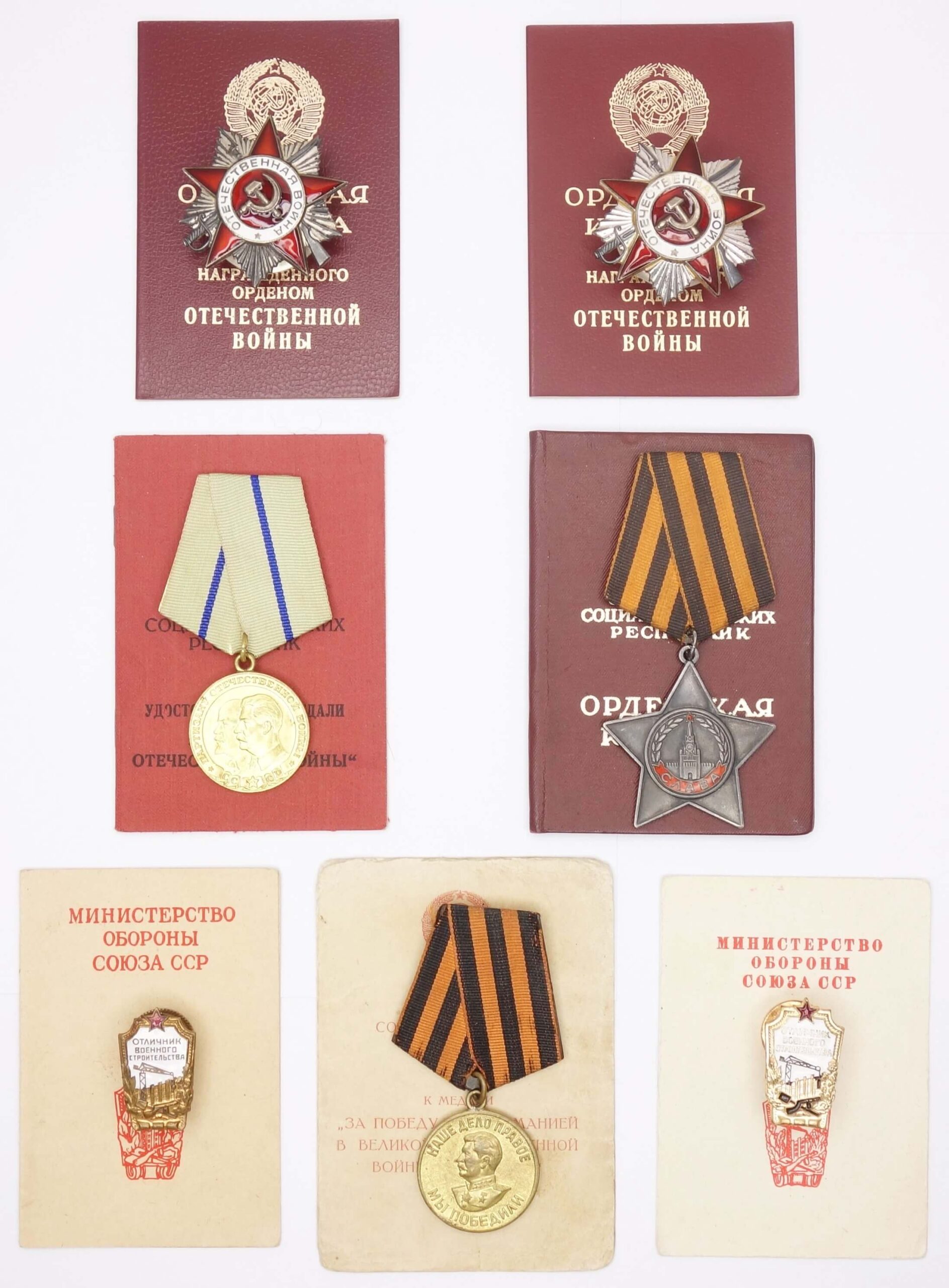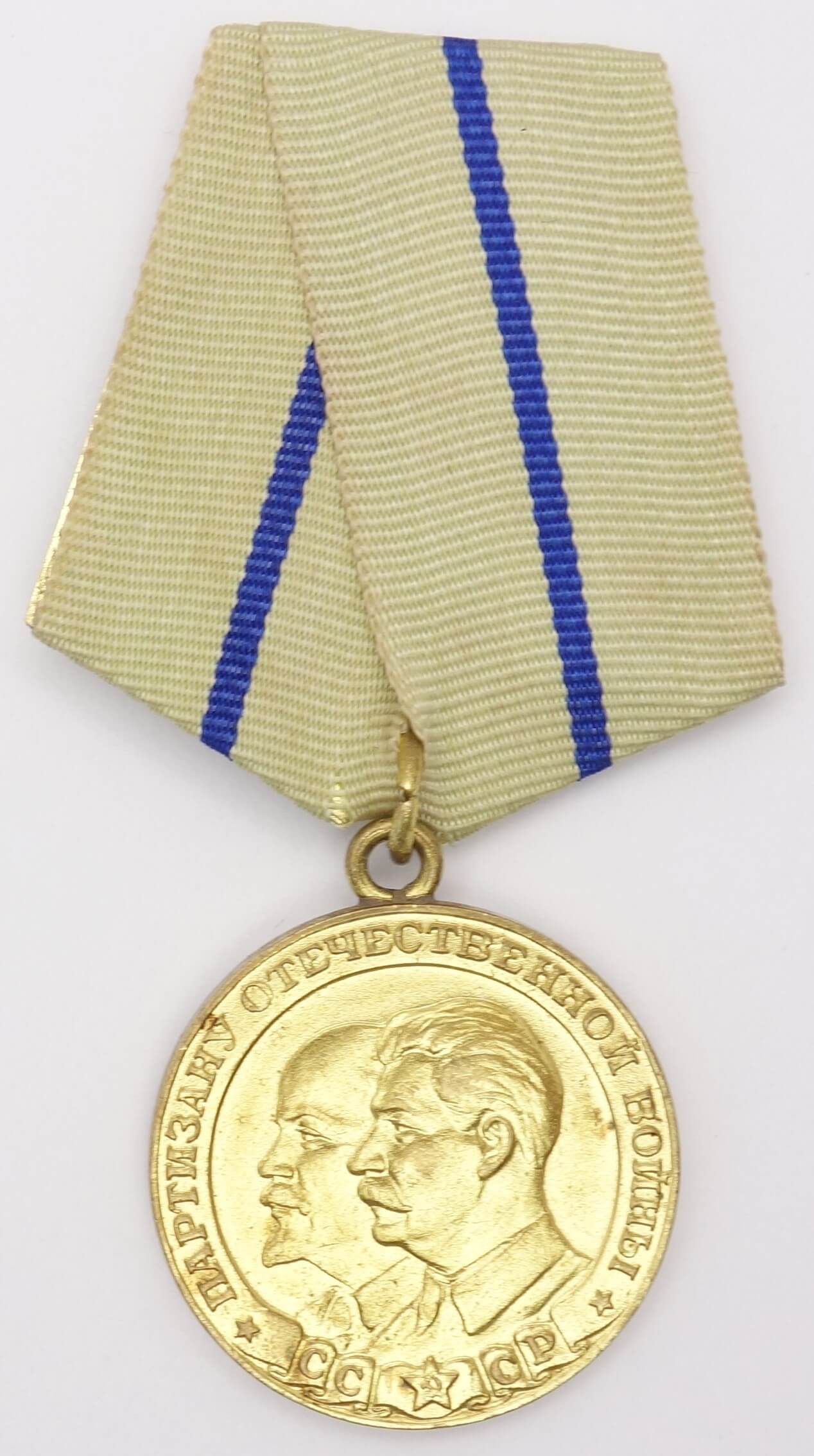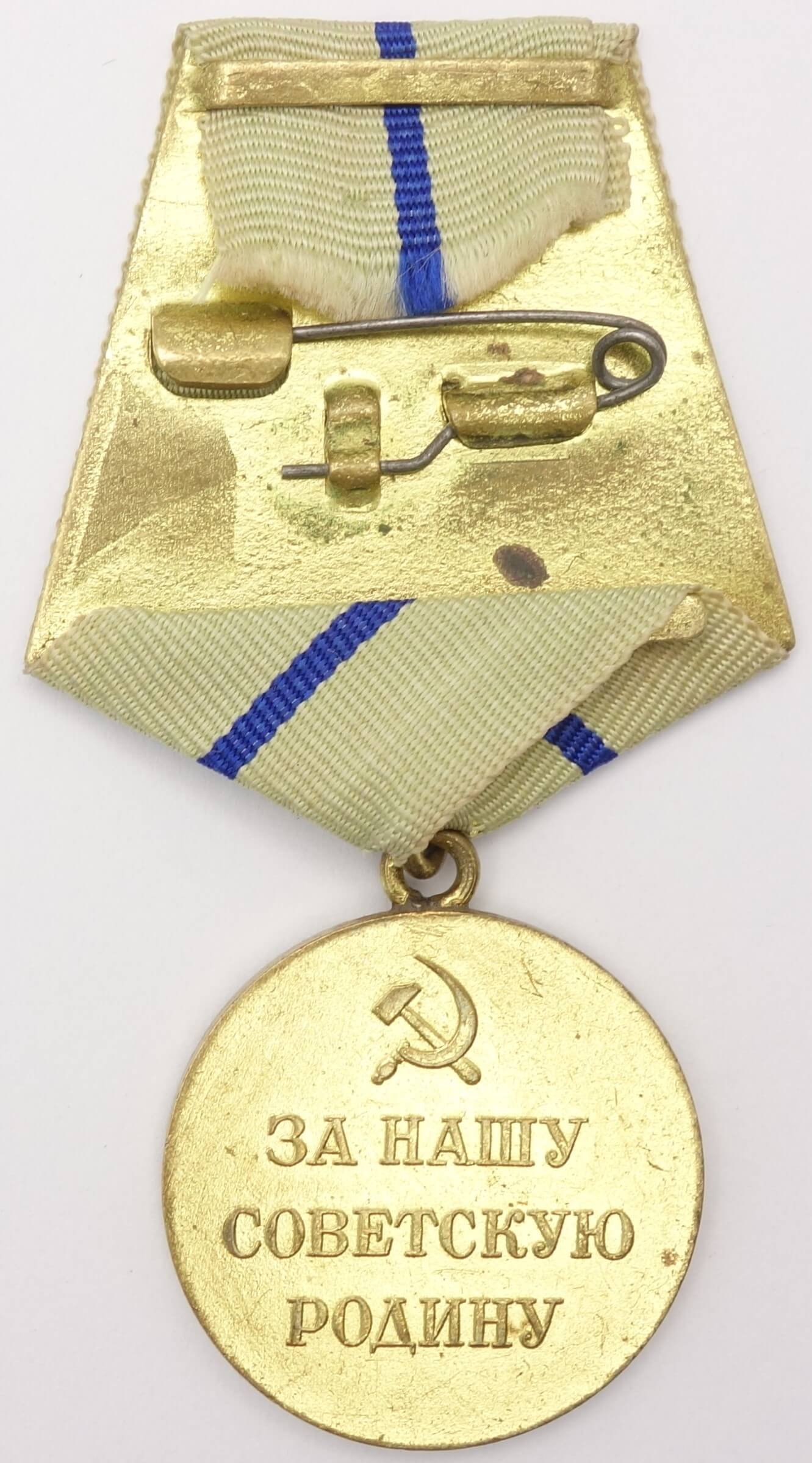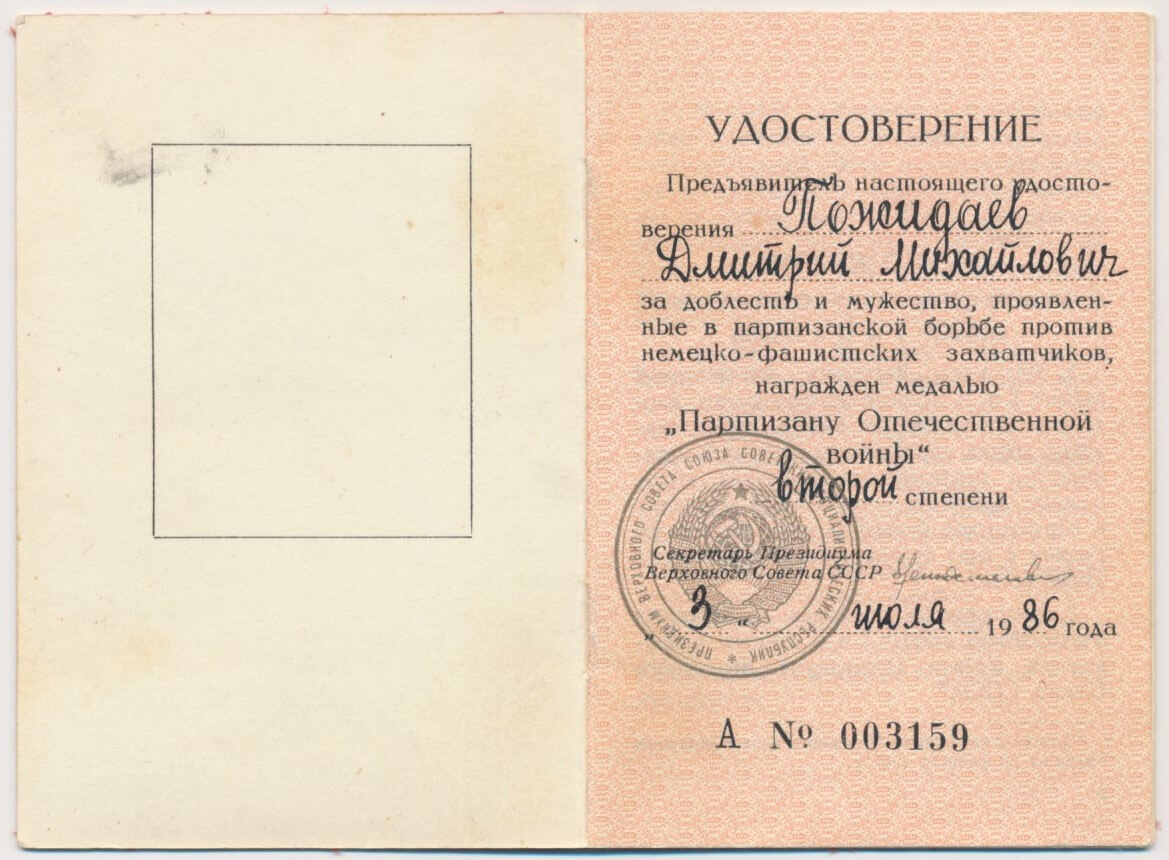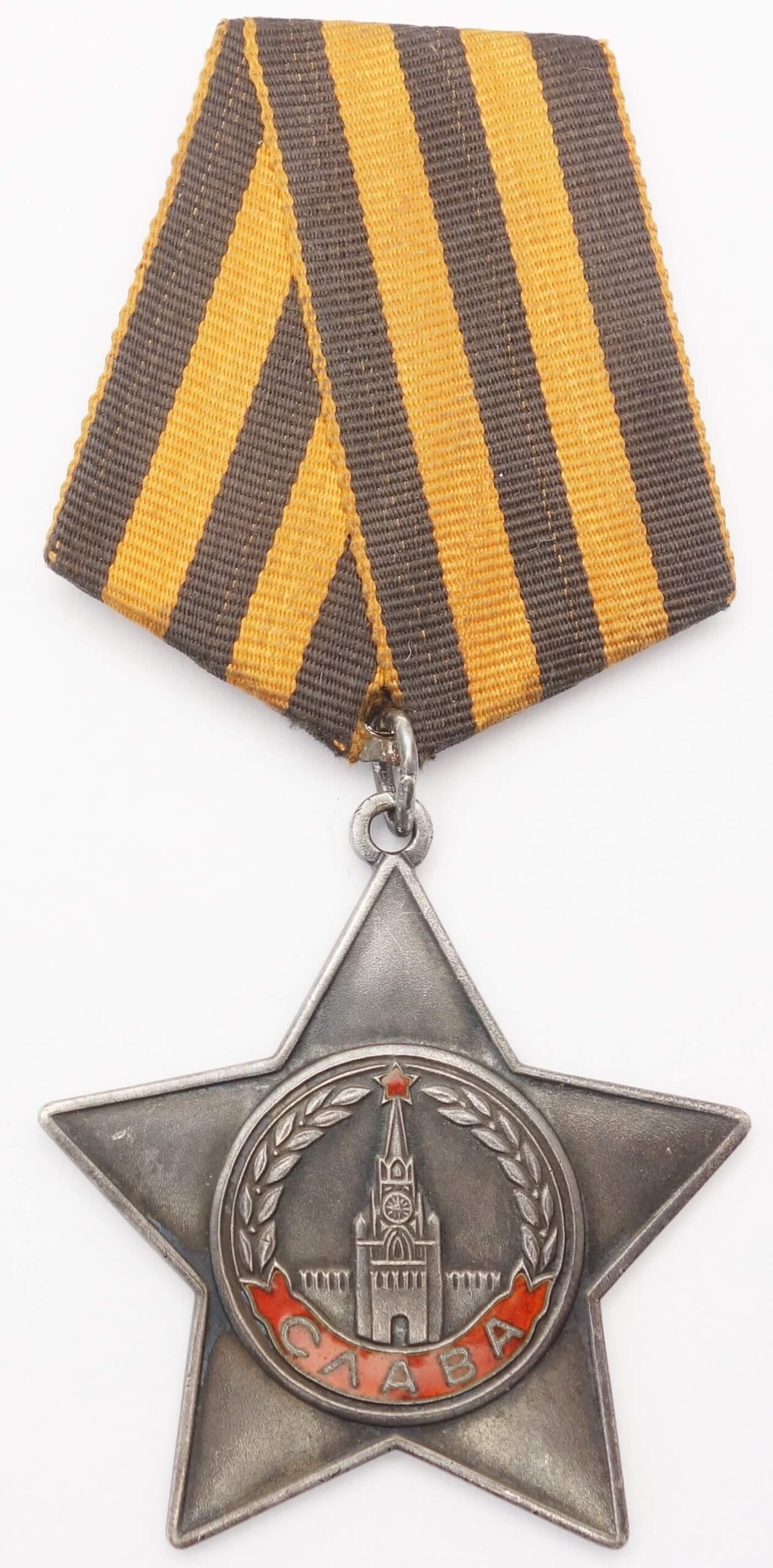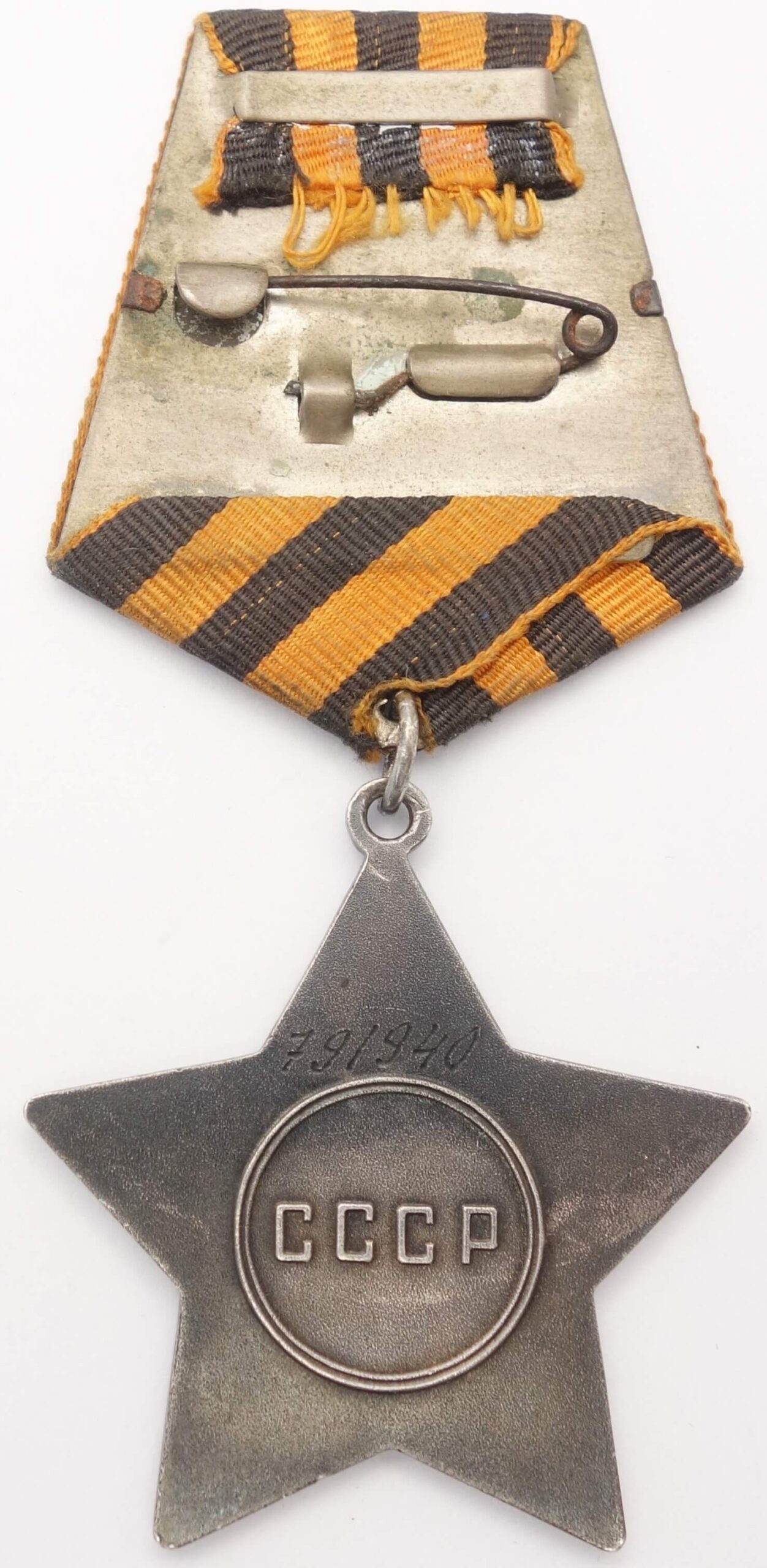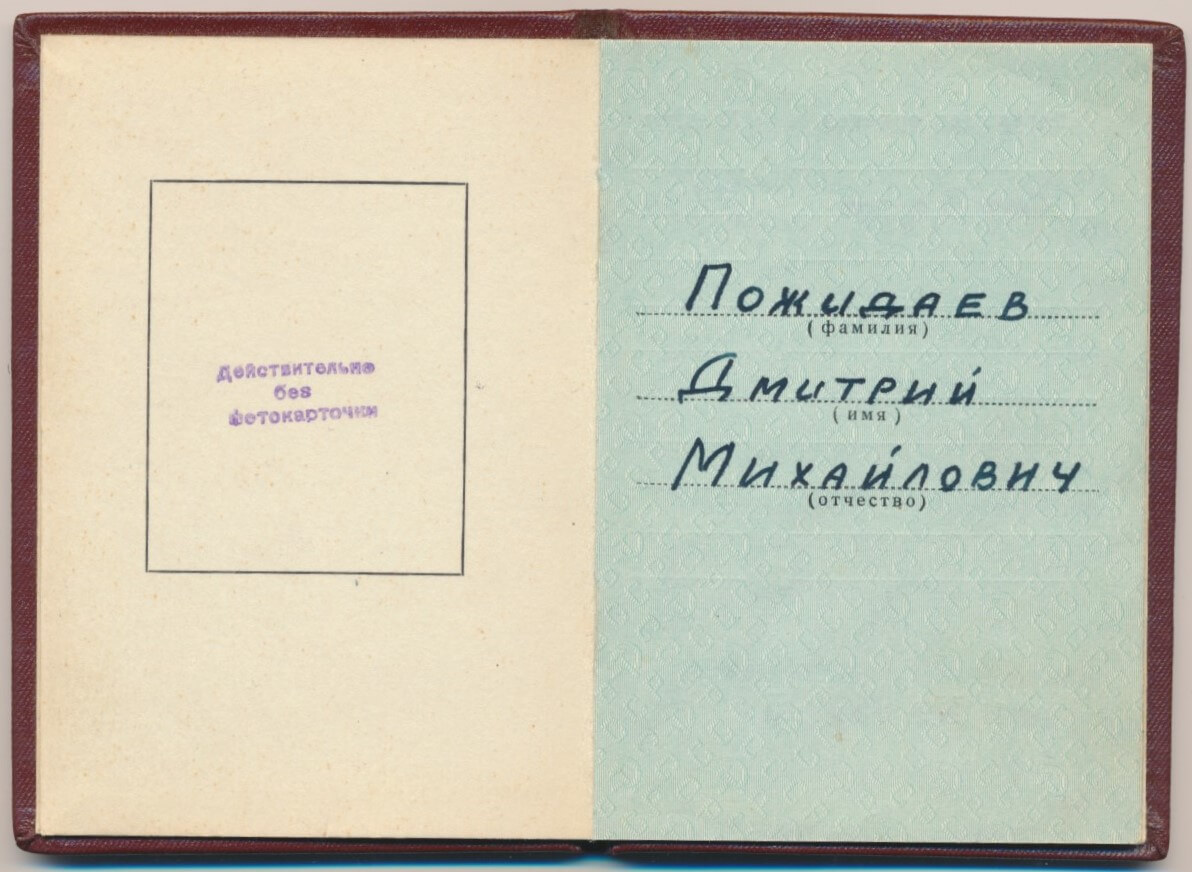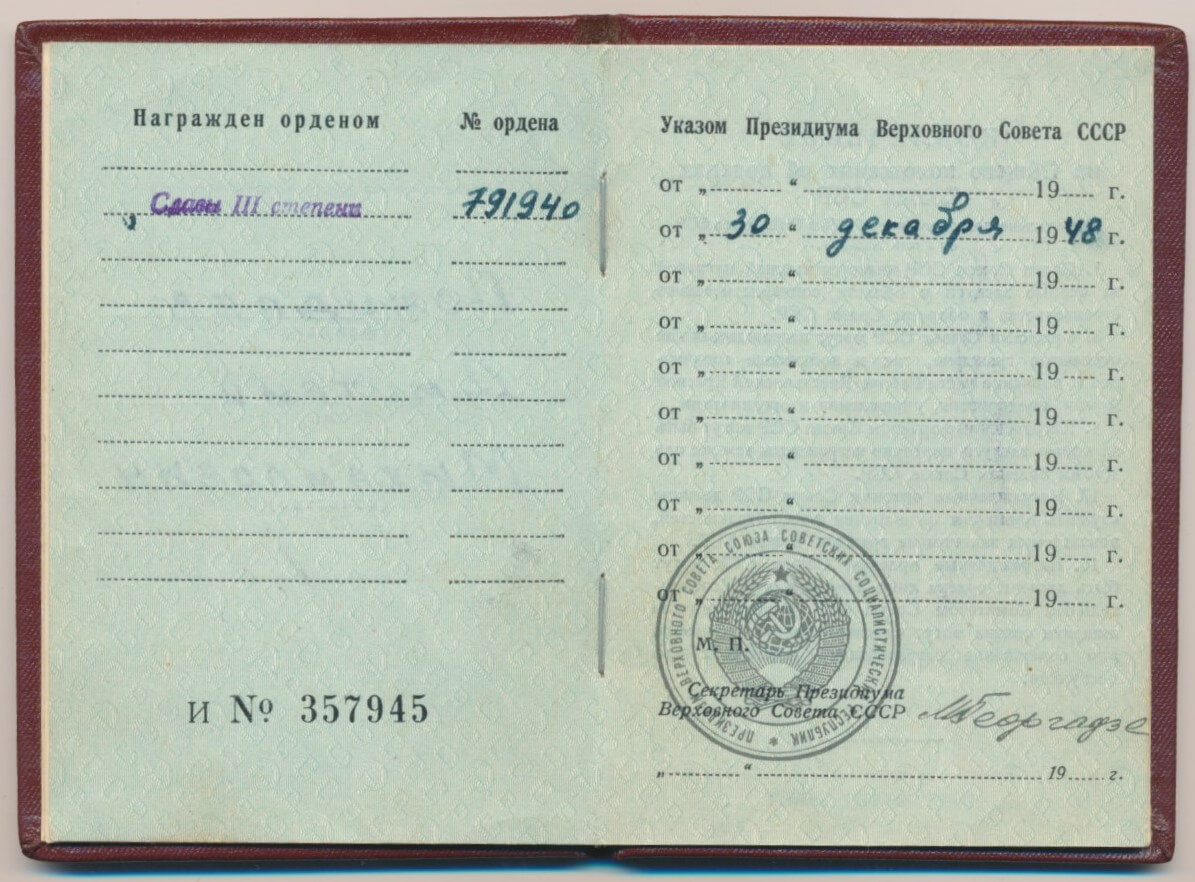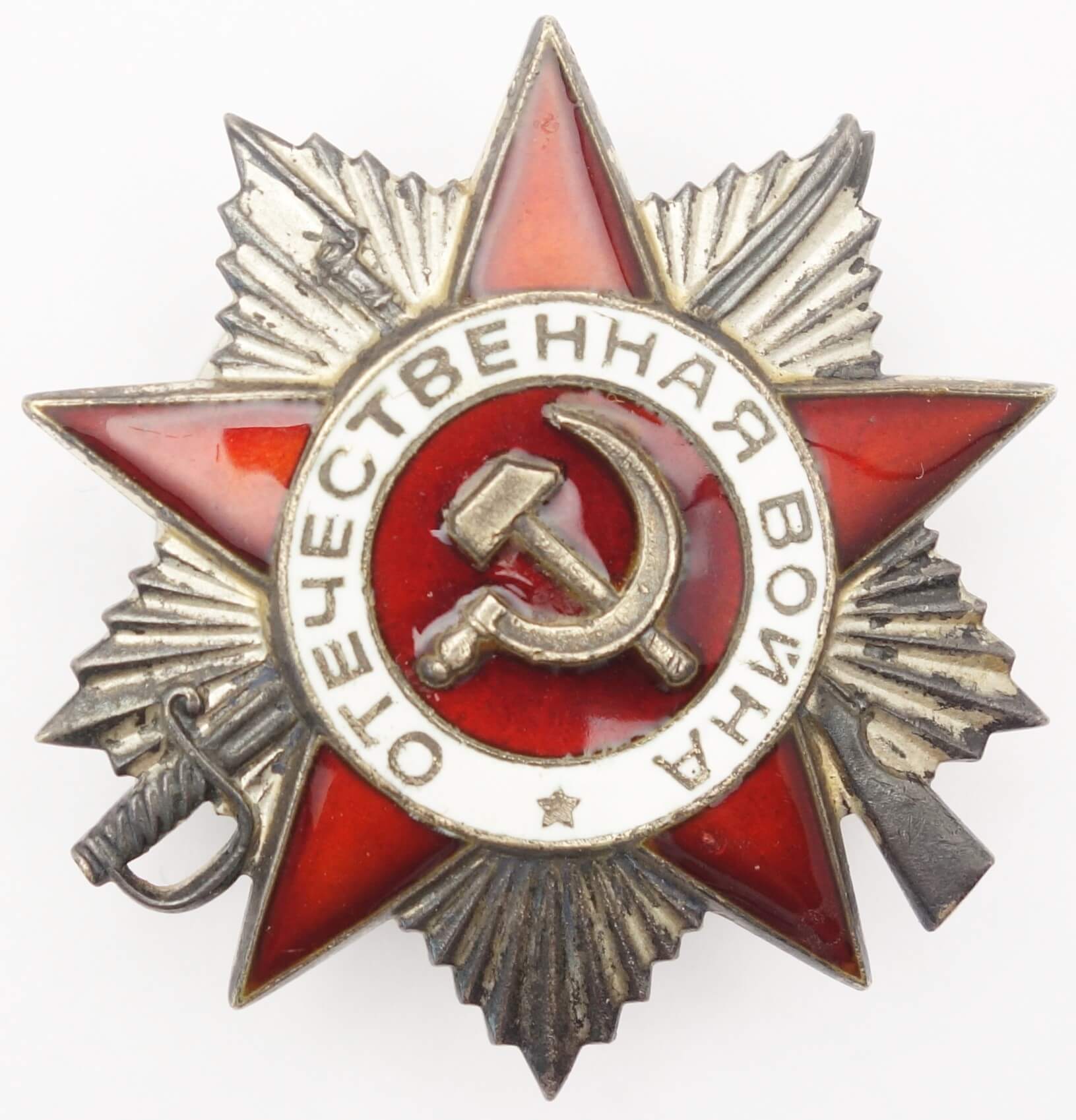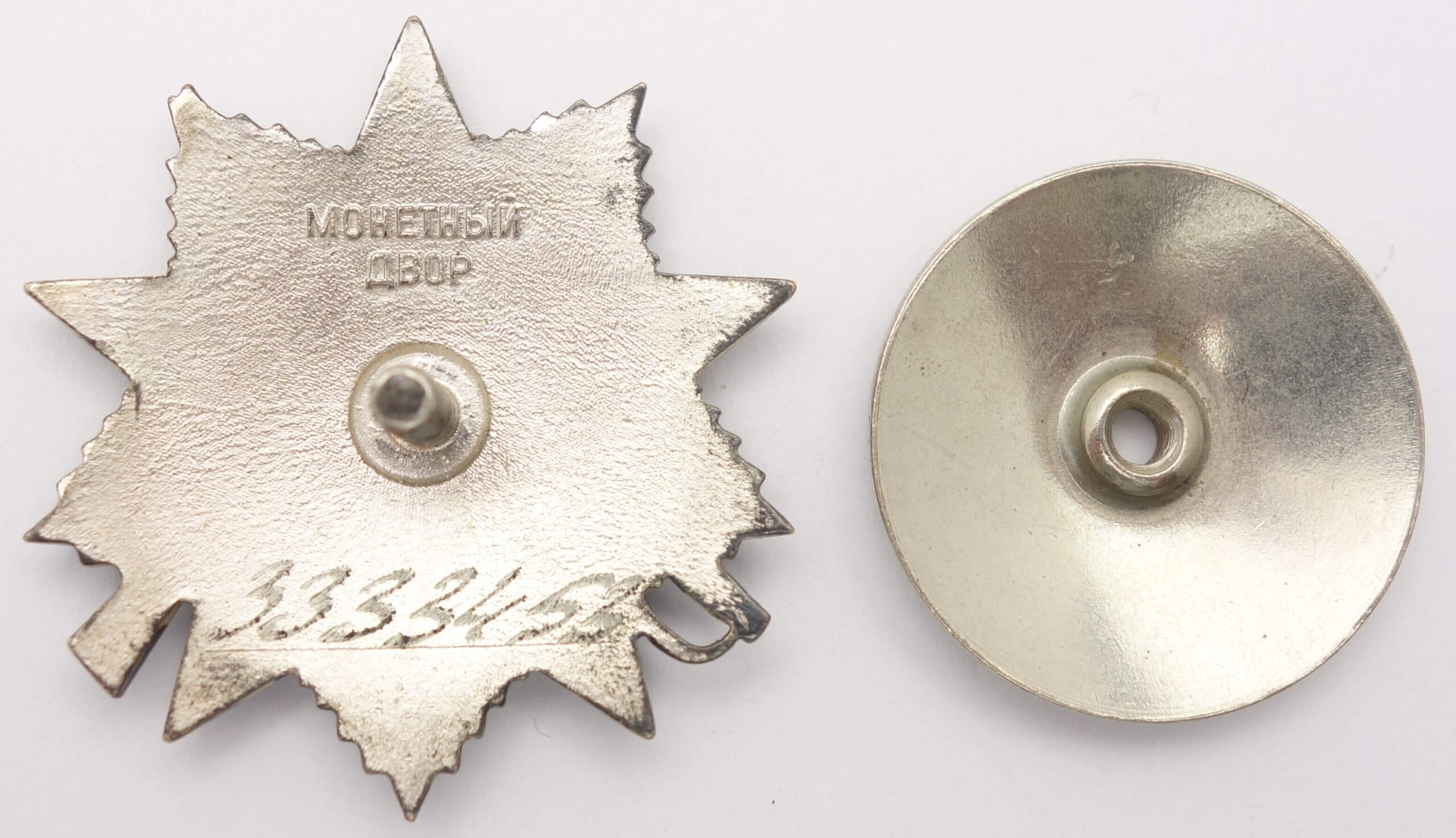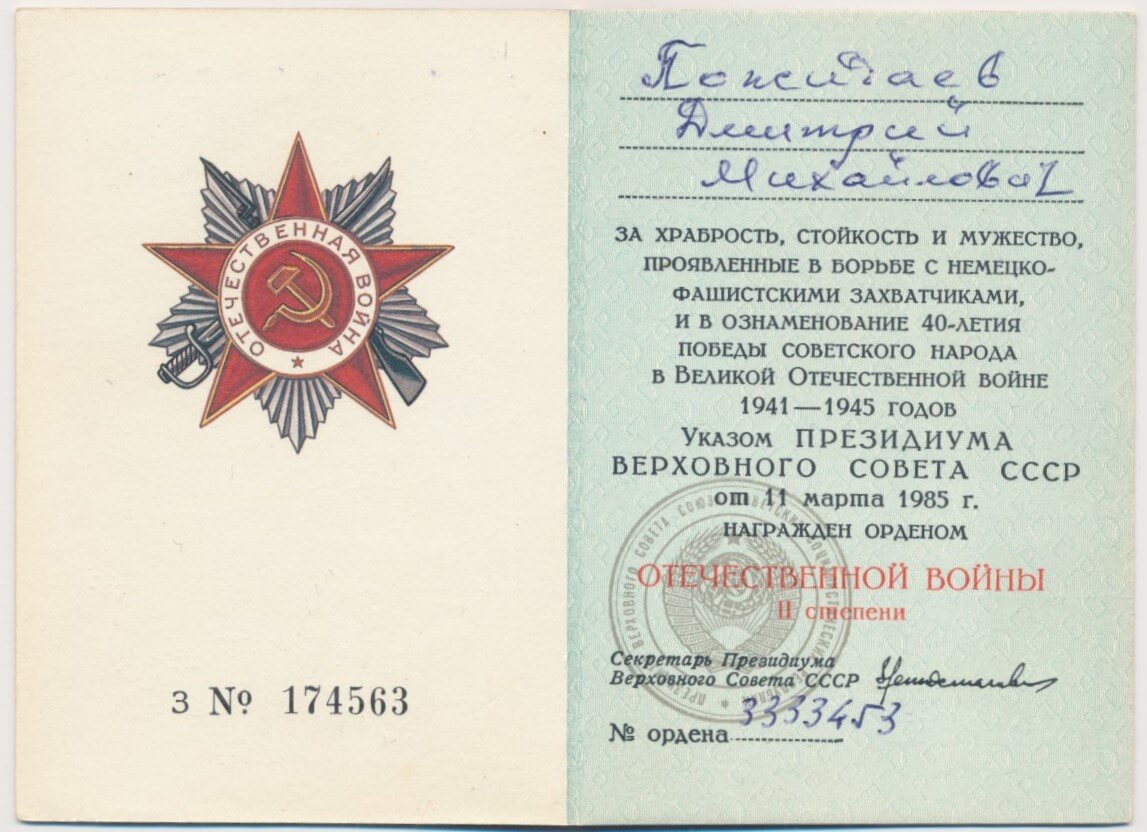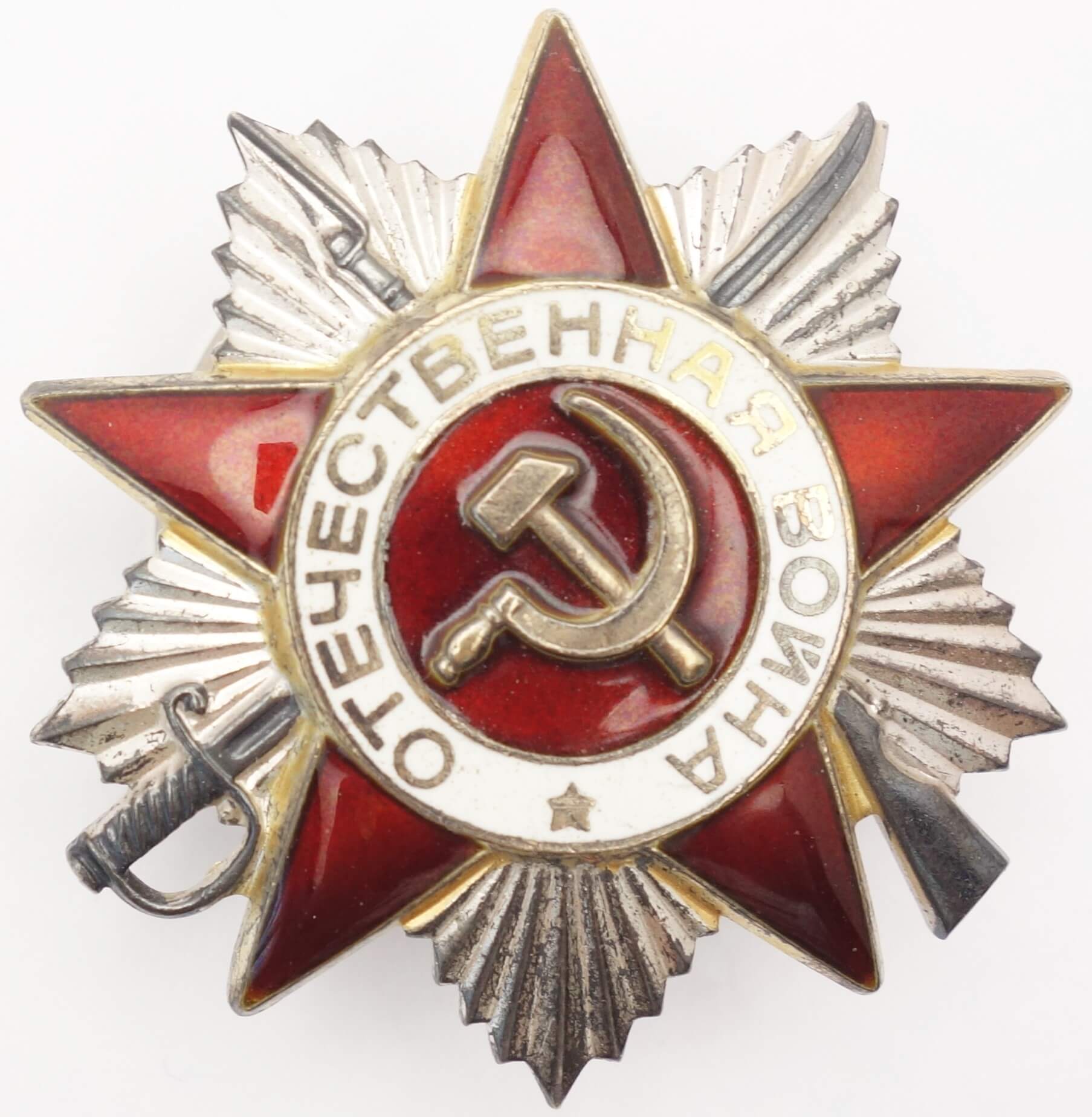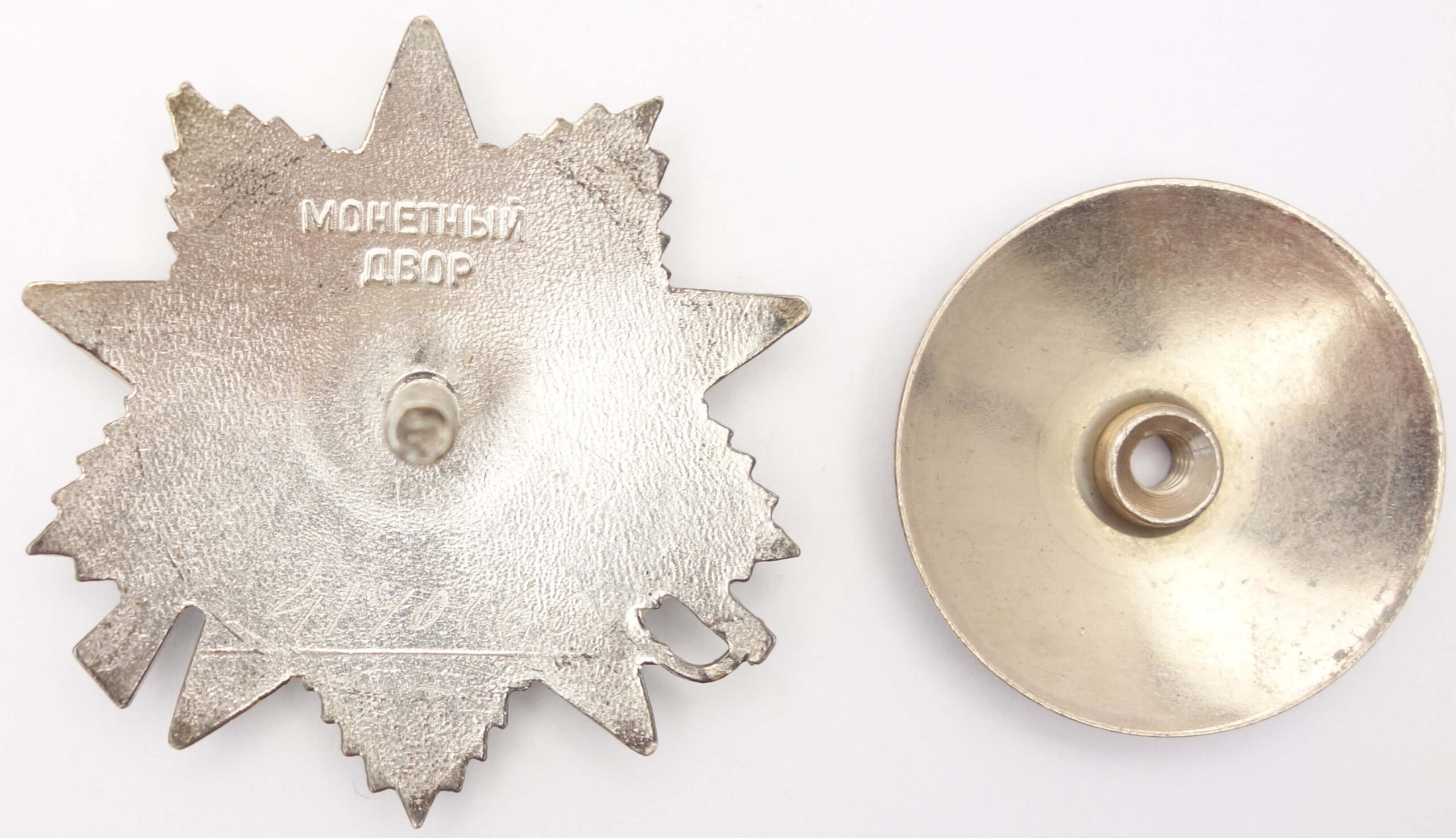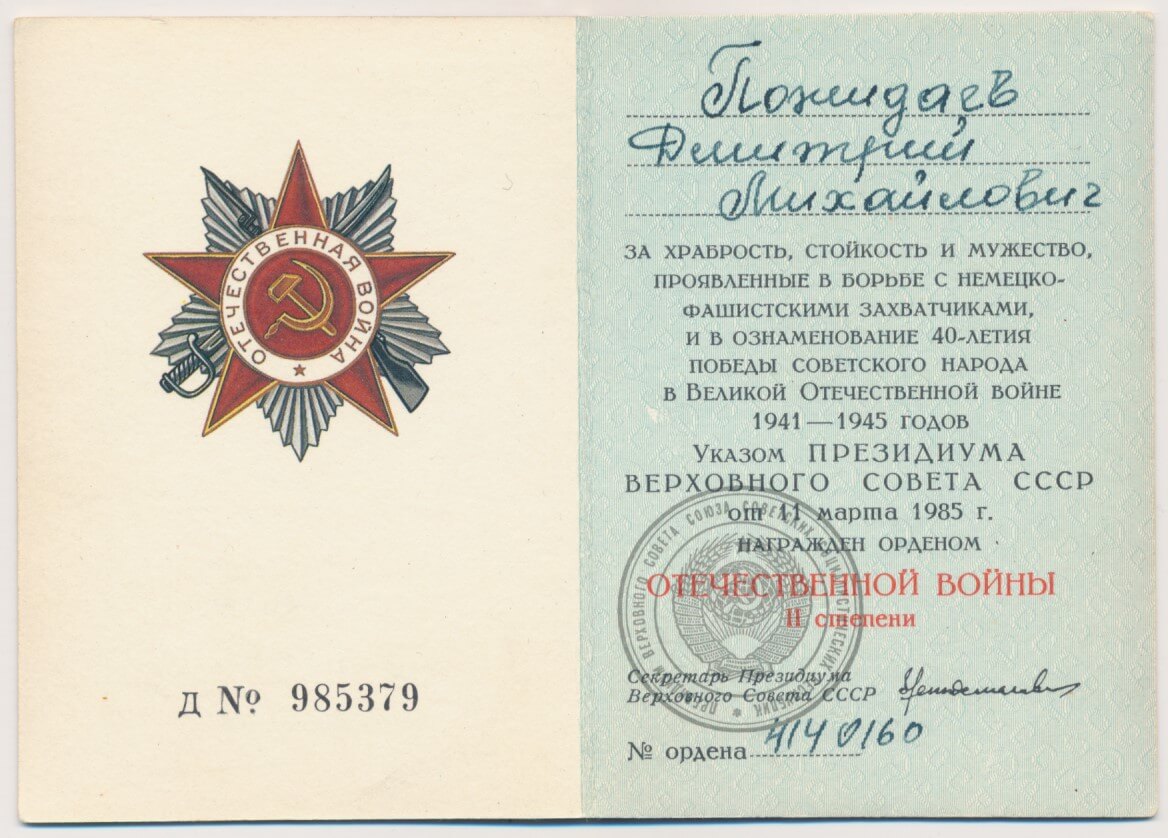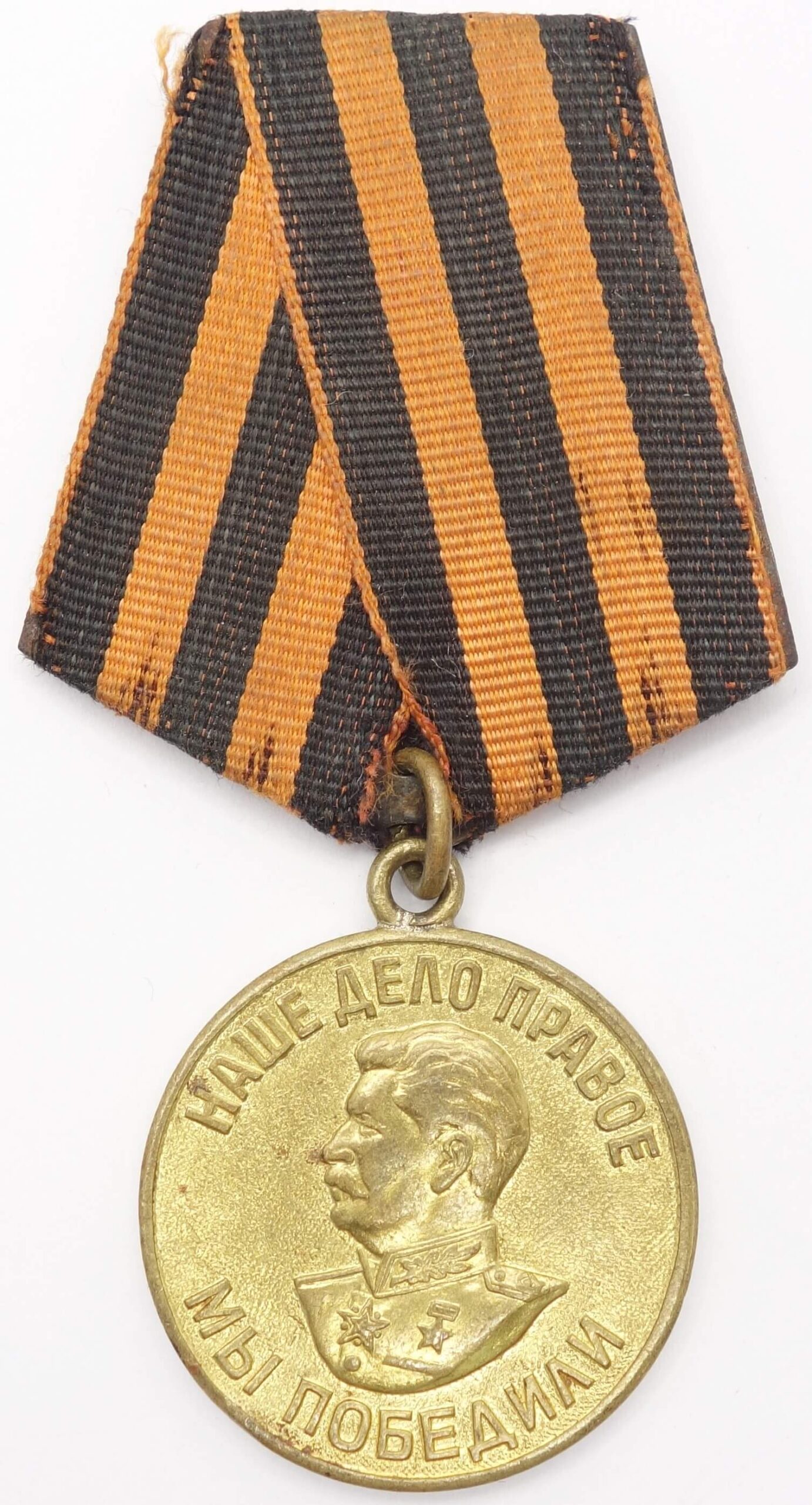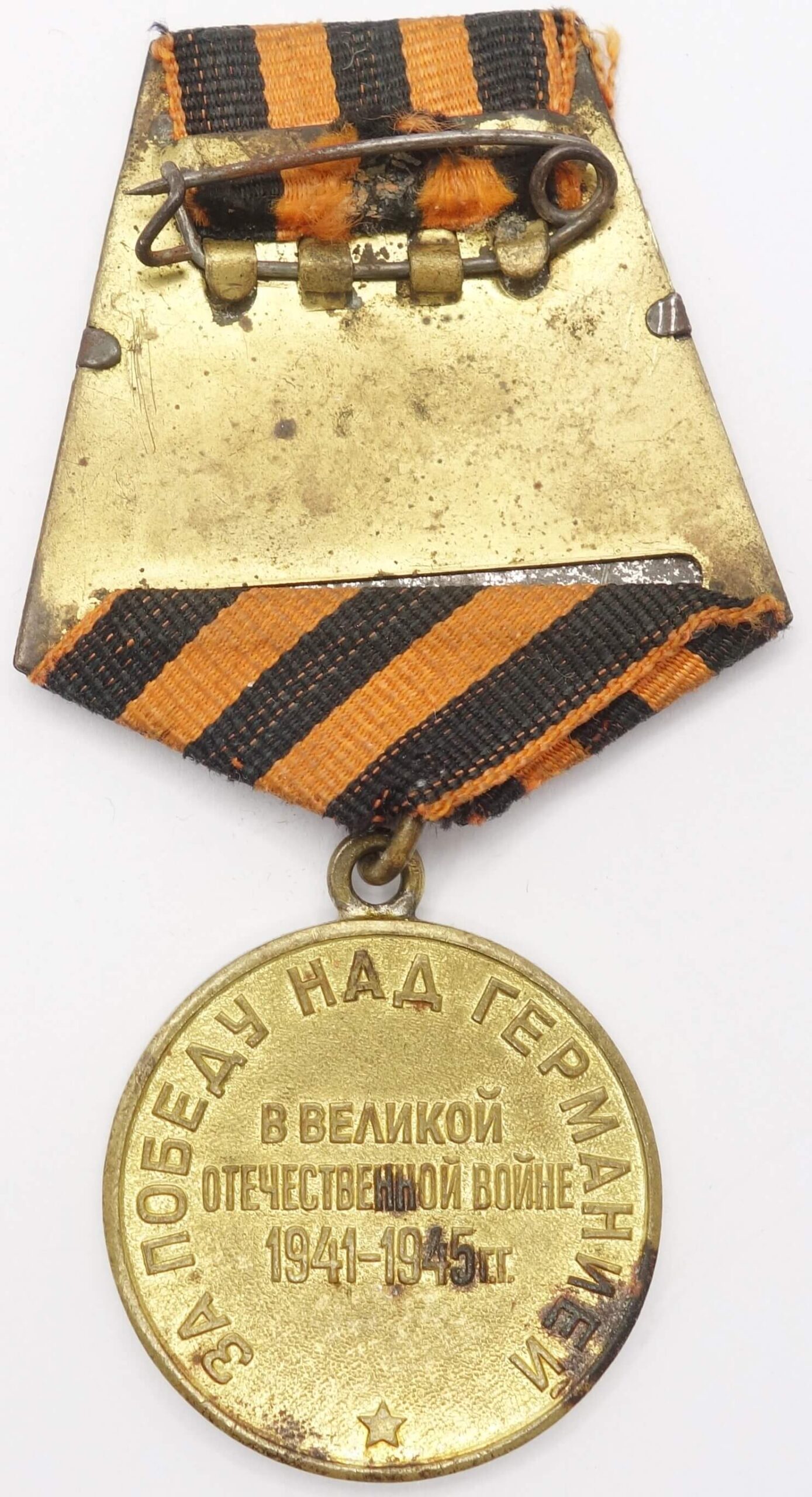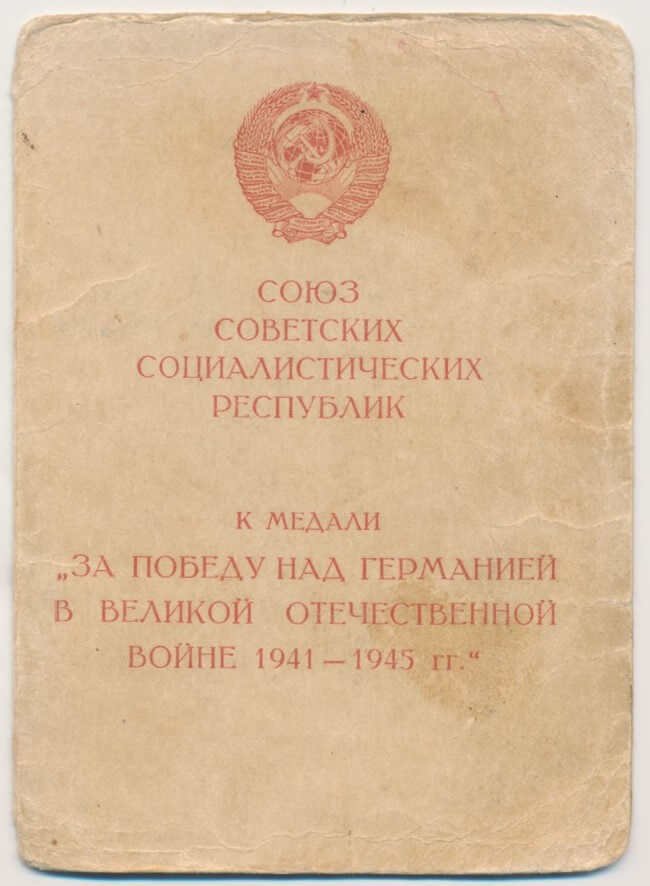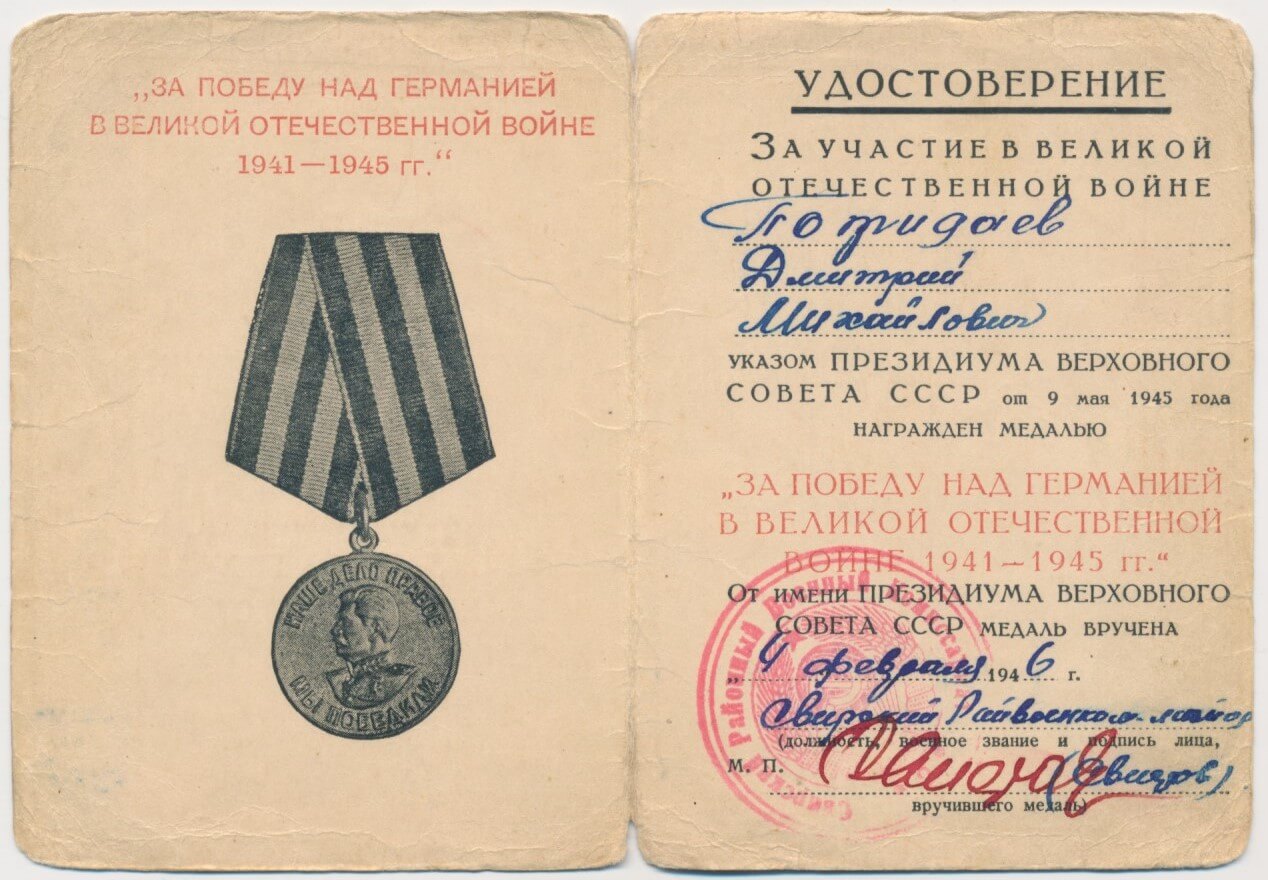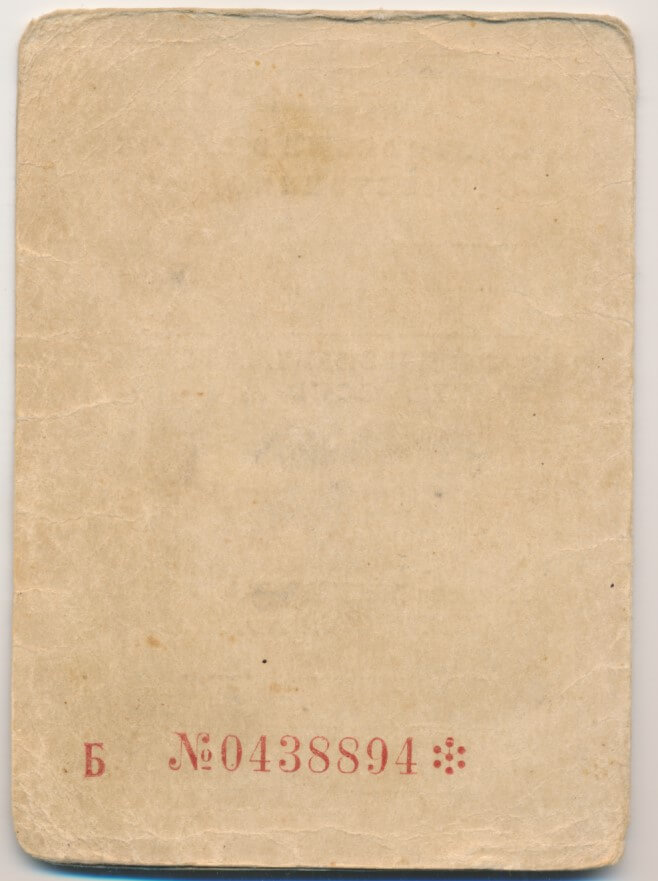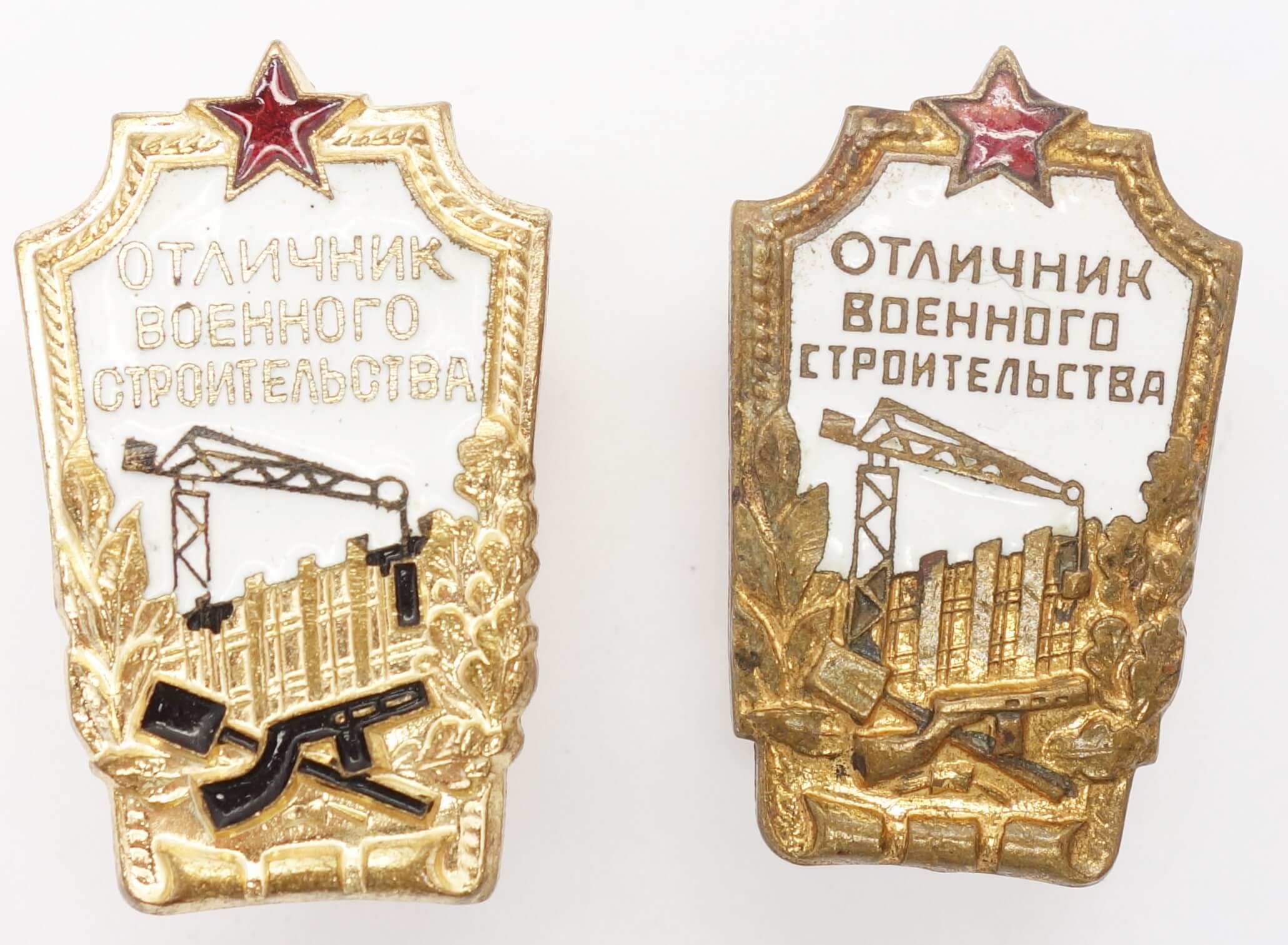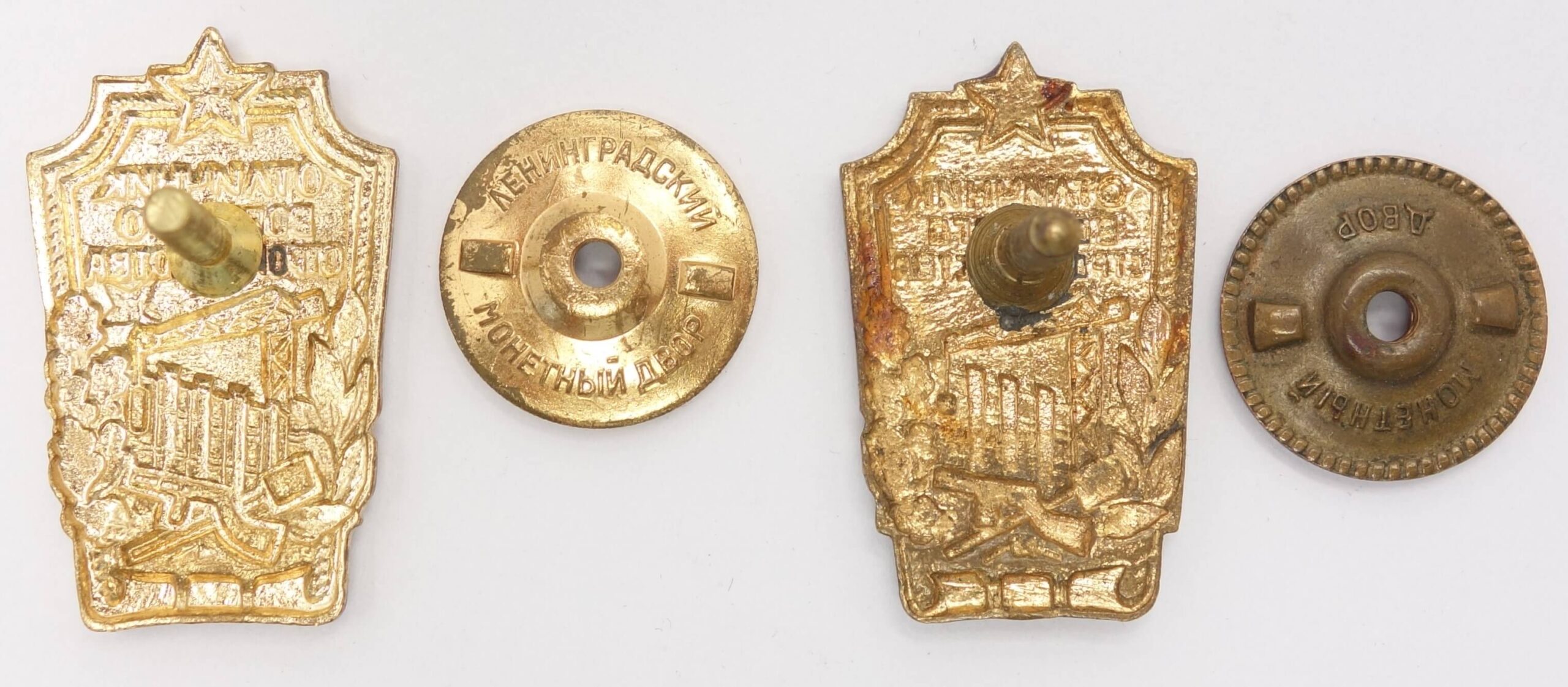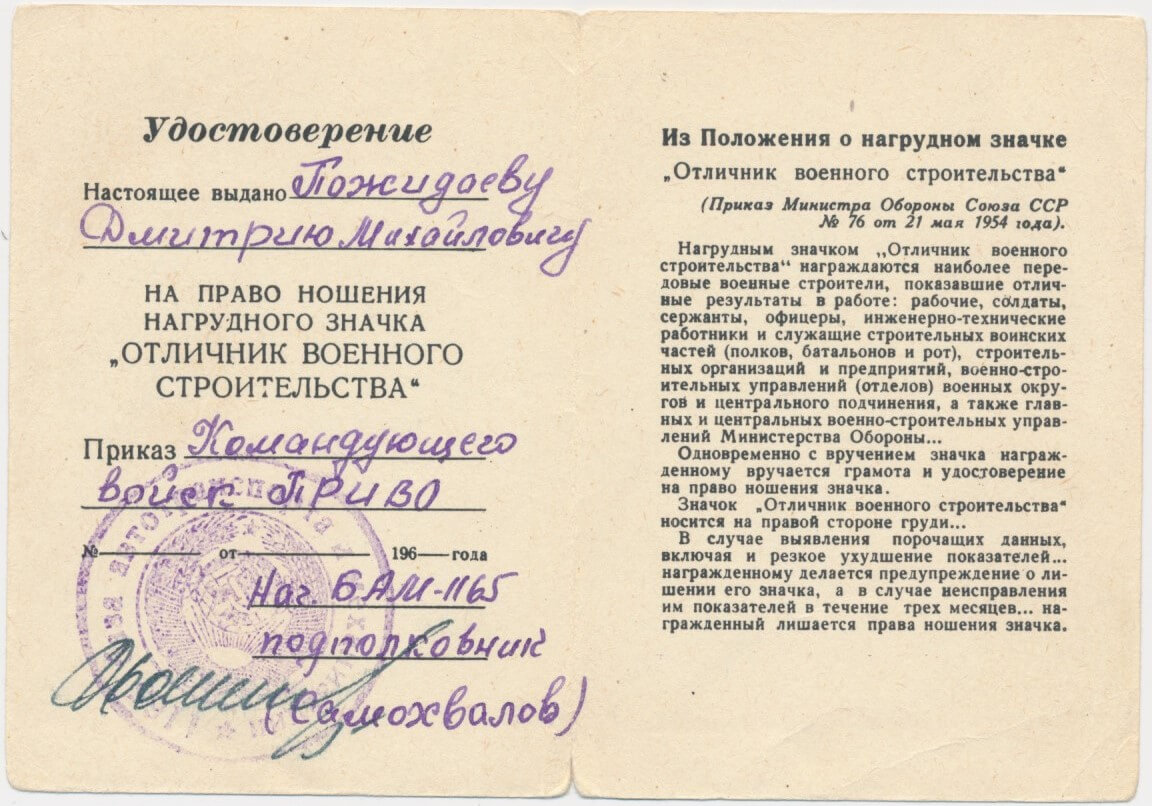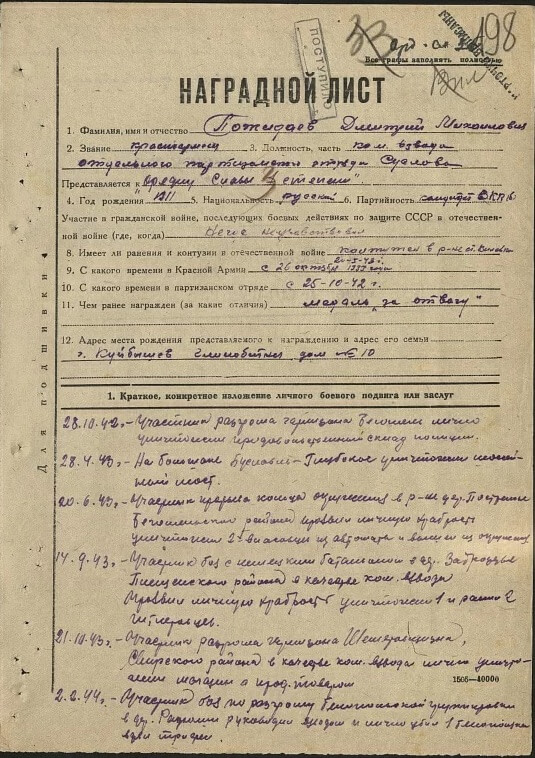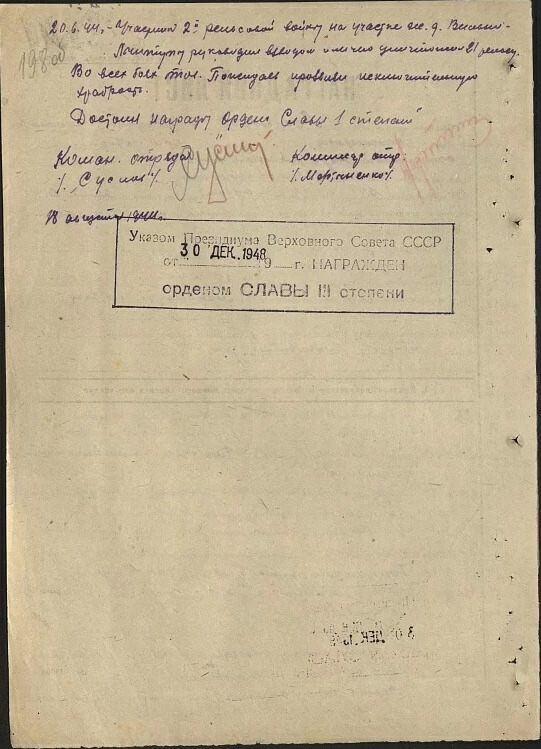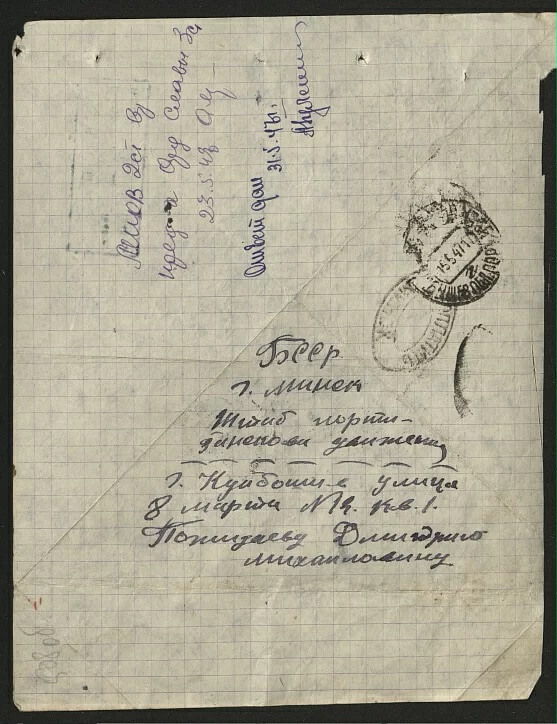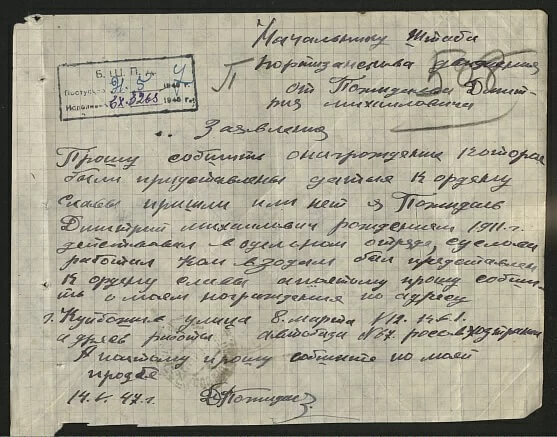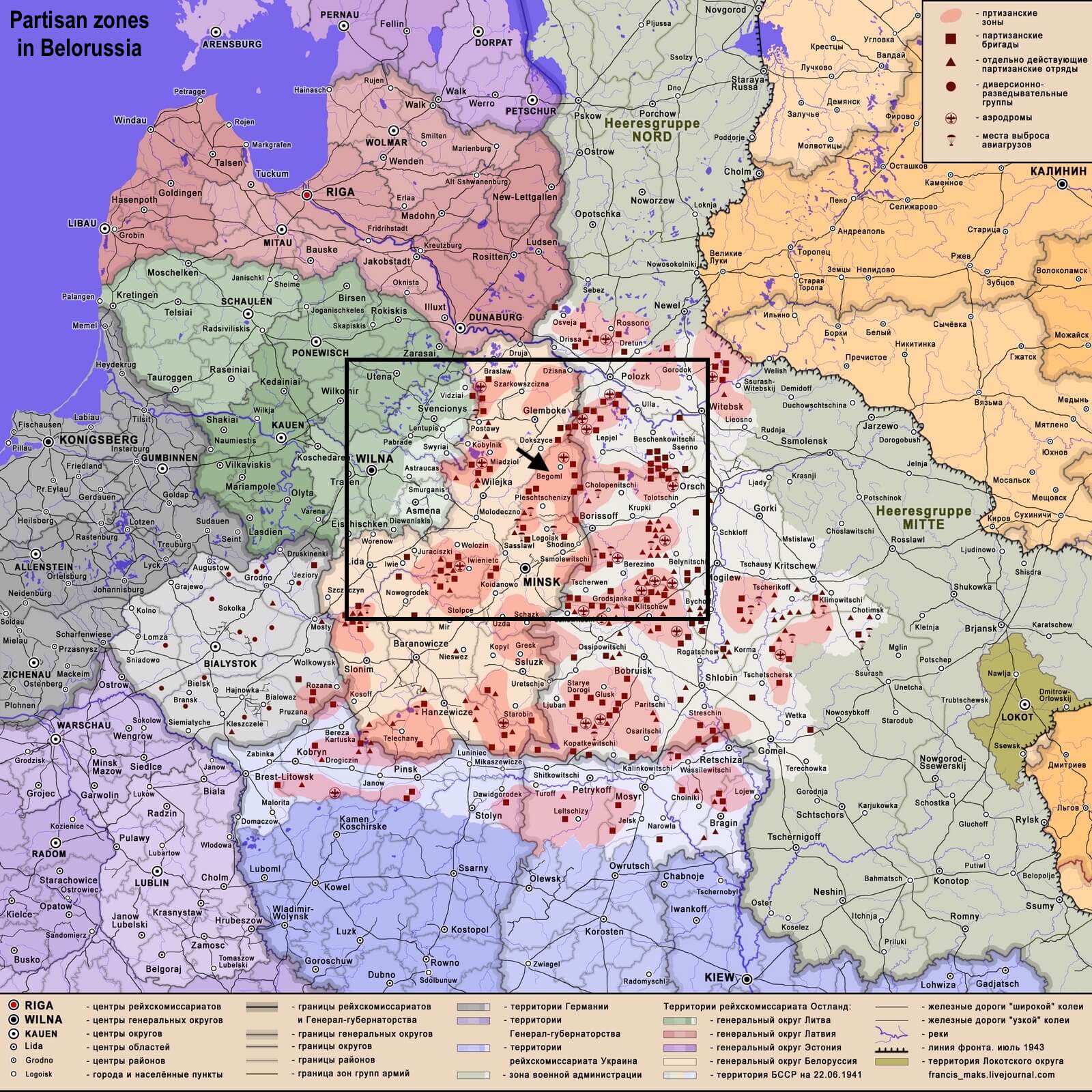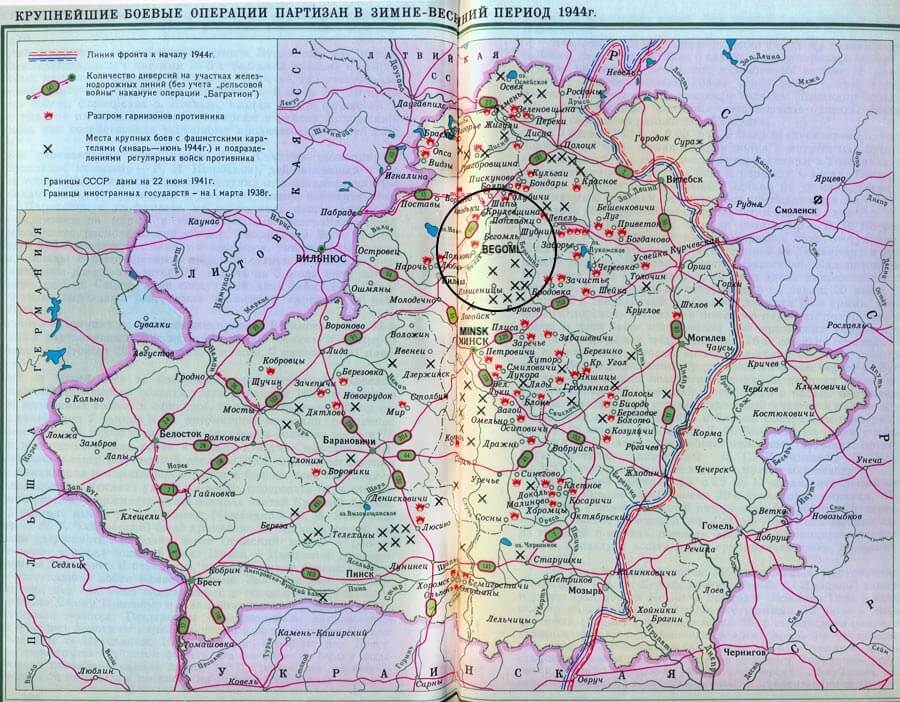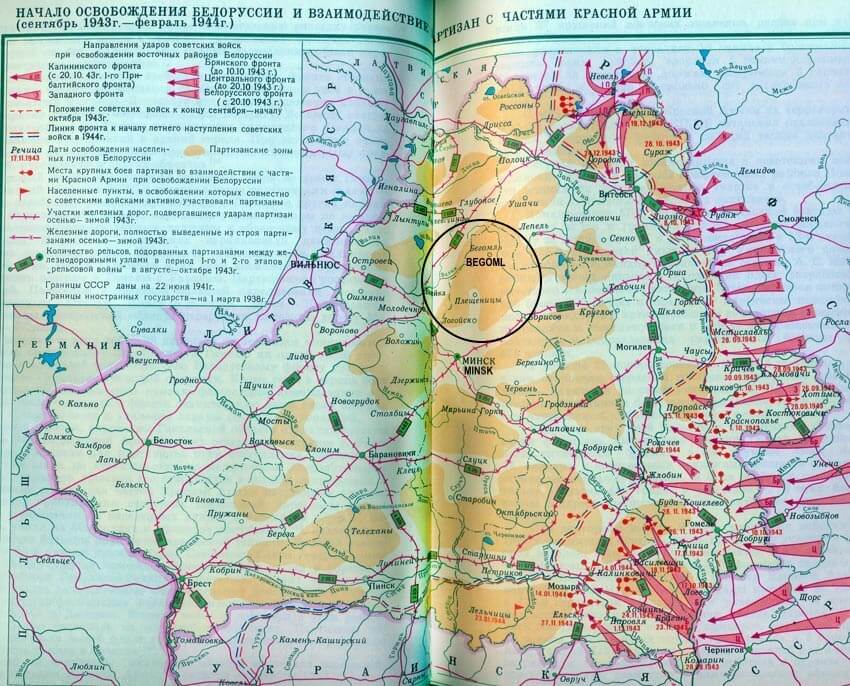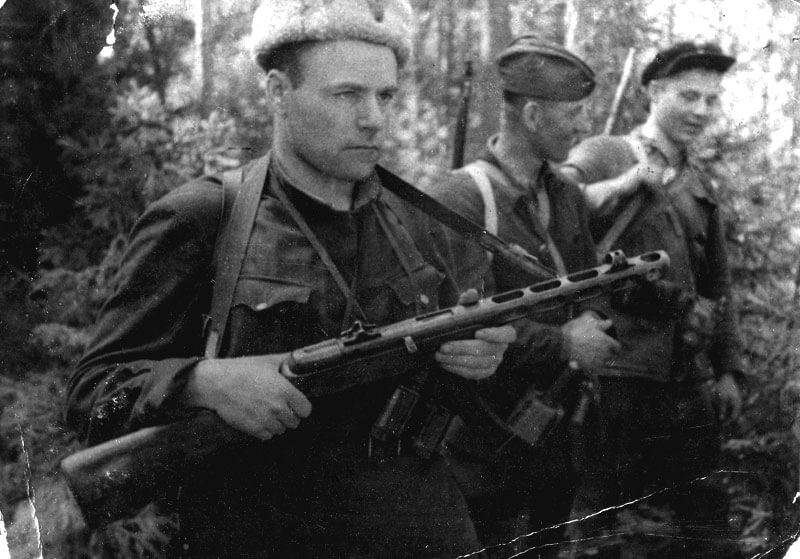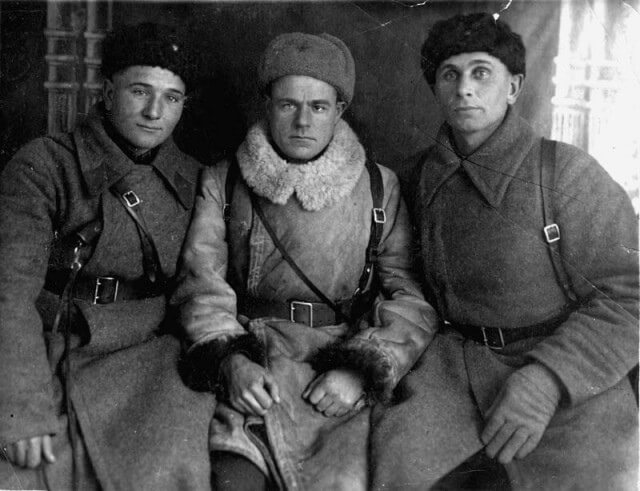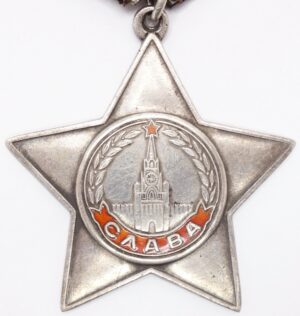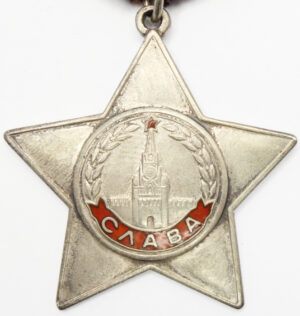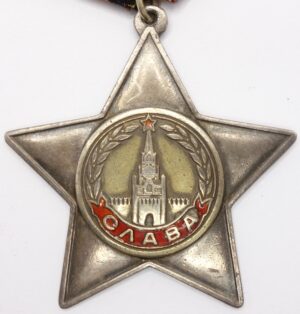Description
Soviet Partisan Group
Awarded to Platoon commander of Suslov’s partisan unit Dmitry Mikhailovich Pozhidaev (Дмитрий Михайлович Пожидаев)
For personally destroying a German police depots, blowing up a bridge and killing 2 Vlasovists and several Germans
This group consists of the following items:
Partisan Medal 2nd class
Made of gold plated brass. Measures 37.24 mm in height including its eyelet, 32.14 mm in width and it weighs 15.3 gram without its suspension.
This partisan medal is in outstanding, near mint condition with full gold plating and perfect details. The lettering, hammer and sickle on its reverse and even the eyelashes of both Stalin and Lenin are very well defined. Its suspension is time period to the medal and there are no repairs. Impossible to upgrade!
Its accompanying booklet is in perfect condition with all pages present and firmly attached. It is numbered A 003159 and dated 3 July 1986(!)
Order of Glory 3rd class #791940
Made of solid silver and enamels. Measures 48.49 mm in height including its eyelet, 46.14 mm in width and it weighs 23.0 gram without its suspension.
This order is in a stunning, near mint condition with perfect details on even the high laying parts like the clock in the tower and the leaves of the wreath. The enamels are outstanding too and show no dings, flaking or repairs. Both sides show an appealing, even dark patina and its connection ring has not been cut. Its suspension and ribbon are original to the order. Like the partisan medal, this order is impossible to upgrade!
The order booklet mentions this order alone and is numbered И 357945. All pages are present without tears or folds.
Order of the Patriotic War 2nd class #3333453
Made of solid silver and enamels. Measures 46.28 mm in height, 44.15 mm in width and it weighs 26.3 gram without its screwplate.
In excellent condition with all details crisp and much plating present. The enamels are beautiful and without dings or scratches and it comes with its well fitted screwplate and full length screw.
Its booklet in perfect condition and numbered З(Z) 174563
Order of the Patriotic War 2nd class #4140160
Made of solid silver and enamels. Measures 46.47 mm in height, 44.63 mm in width and it weighs 26.3 gram without its screwplate.
In excellent condition with all details crisp and most plating present. The enamels are beautiful and without dings or scratches and it comes with its well fitted screwplate and full length screw.
Its accompanying document is in pristine condition and numbered Д(D) 985379
Medal for the Victory over Germany
Made of gold plated brass. Measures 37.56 mm in height including its eyelet, 32.39 mm in width and it weighs 17.3 gram without its suspension.
In excellent condition with all details crisp and relatively few dings and scratches. Its early double layer suspension is time period to the medal as is its ribbon.
Its award booklet is in worn but problem free condition. It is dated 4 February 1946 and numbered Б(B) 0438894
Two badges for Excellence in Military Construction (two variations)
Both badges are made of gold plated brass and are in excellent condition with crisp details. The enamels are problem free and most gold plating is present, especially on the later piece. The badges come with their original documents.
Citation for his Order of Glory:
20.10.1942 – He participated in the destruction of the enemy garrison in the settlement Begoml in the capacity of a platoon commander, where he personally destroyed German police food depot.
28.04.1943 – He blew up a bridge on the main road Buslavl-Glubokoe.
20.06.1943 – He participated in braking through the enemy blockade near the village Postrezhie, Begoml district. He exhibited courage, killed 2 Vlasovists by the fire of his submachine gun, and escaped the encirclement.
14.09.1943 – He participated in the battle against a German battalion in the village Zabrodie. Being a platoon commander, he exhibited courage, killing 1 and wounding 2 Hitlerites.
21.10.1943 – He participated in the raid against the garrison of the settlement Sheteravschizna (?), Svirsky district in the capacity of a platoon commander. He personally demolished the enemy shop and the food depot.
02.02.1944 – He participated in the raid against the enemy garrison in the village Radyumni (?), Begoml region. He commanded his platoon and personally killed 1 ???, and captured enemy equipment.
26.06.1944 – He participated in the 2nd “rail war” on the stretch of the Wilno rail line. He led his platoon into the action and personally destroyed 21 rail segment. Comrade POZHIDAEV has been exhibiting personal courage in all the combat engagements.
He deserves state award – order “GLORY 1 CLASS”.
Short history of the “Zheleznyak” partisan brigade
The combat path of the partisan detachment, and later the “Zheleznyak” partisan brigade, began in April 1942 and ended in August 1944 (when the partisans reunited with the advancing Red Army).
During this time, the brigade defeated 14 enemy garrisons in a series of fierce battles, including the engagements the settlements Begoml, Dolginov, Dokshitsy, Vyazin, Parafyanovo station, disabled the Minsk-Vitebsk highway, the roads Dokshitsy-Lepel, Dokshitsy-Pleschenitsy, Begoml-Borisov.
On its account, there are a hundreds destroyed bridges, including the ones across the rivers Berezina, Serguch, Ponya, Viliya, Tsna, Dvina. The brigade eliminated several thousand enemy troops, took many prisoners, destroyed over two hundred trucks and cars, 34 tanks and armored cars, derailed over 50 rail trains. It led the negotiations and enabled the transition from the German to Soviet side of the so-called “1st Russian national brigade” under the command of GIL-RODIONOV. The brigade withstood 4 enemy anti-partisan task force operations, including the two major ones “Cottbus” (20.05 – 24.06 of 1943) and “Kormoran” (25.05 – 17.06 of 1944). Together with other brigades, it thwarted the attempts of the Germans to create a defensive line on the Berezina bank north of town Borisov.
By the joint efforts of the Zheleznyak brigade and other detachments and brigades, the Borisov-Begoml partisan zone was created.
The brigade carried out many operations to destroy the railway tracks, telephone and telegraph lines, and assisted in the rapid advance of the regular troops of the 3rd Belorussian Front.
The Zheleznyak brigade was created on the basis of the Begoml region underground, which transferred its best patriots to its ranks. One of its first partisans, the organizer and political leader was the secretary of the regional party committee Stepan Stepanovich MANKOVICH.
The brigade consisted mainly of local residents, which was especially important and provided a significant advantage. The partisans knew their area, people and conditions. This made it easier to deal with material support. The Begoml region sent about 23% of its population to the partisans. Practically, there was a partisan in almost every family.
Among the brigade troops, there were only 8% who were former POW escaped from German captivity. The number of the brigade active fighter sometimes exceeded 2.5 thousand people. In addition to this strength, there were several hundred fighters in the reserve, training, and logistic units. Plus, several thousand in the local village self-defense militia. This meant, that the total brigade strength could rise up to 3-4 thousand people during the battles with the punitive anti-partisan forces.
The Borisov-Begoml zone was a permanent part of the partisan front. This territory was of great importance for the invaders, especially on the eve of the Red Army’s offensive in Belarus. Therefore, the Nazis more than once made attempts to eliminate this partisan zone.
Operation “Cottbus” took place from May 20 to June 21, 1943. In the course of it, punitive forces burned dozens of villages, killed about 10 thousand people, and took 605 people to work in Germany.
The last operation against the partisan movement in the Polotsk-Lepel and Borisov-Begoml zones was Operation “Kormoran”. It began in the spring and ended in the early summer of 1944. The purpose of the operation was to push the partisan formations into impassable swamps in the area of Lake Palik and to completely destroy them there by heavy artillery and air strikes. The brigades “Zheleznyak” and “People’s Avengers” managed to escape the encirclement into he Kromovichi forest on 7-8 June 1944 near the villages of Zherdyazhye and Okolovo.
On 26 June 1944, “Zheleznyak” brigade (2137 partisans of the 1st, 2nd, 3rd, 4th, 5th, 6th, 7th and training reserve detachments) united with the Red Army regular troops. The brigade commander I.F. TITKOV and Commissioner S.S. MANKOVICH were awarded the title of Hero of the Soviet Union.
Next to the ‘regular’ research we included scans of images of the commander of Zheleznyak partisan brigade Hero of the Soviet Union TITKOV in the picture gallery.
Also included is a letter from the archive which is written by POZHIDAEV to the Belorussian partisan headquarters asking to clear the situation about his OGIII recommendation. He was bestowed it a year later so possibly some paperwork didn’t work properly until much later.
Interesting to note in this group is that the citation was originally written for an Order of Glory 1st class. Also interesting to see that Pozhidaev received two jubilee orders of the Patriotic War. This rarely happened.
An truly remarkable group with very unusually detailed information on the partisan’s feats and items in stunning condition. Rare as such
Please contact us if you have questions
